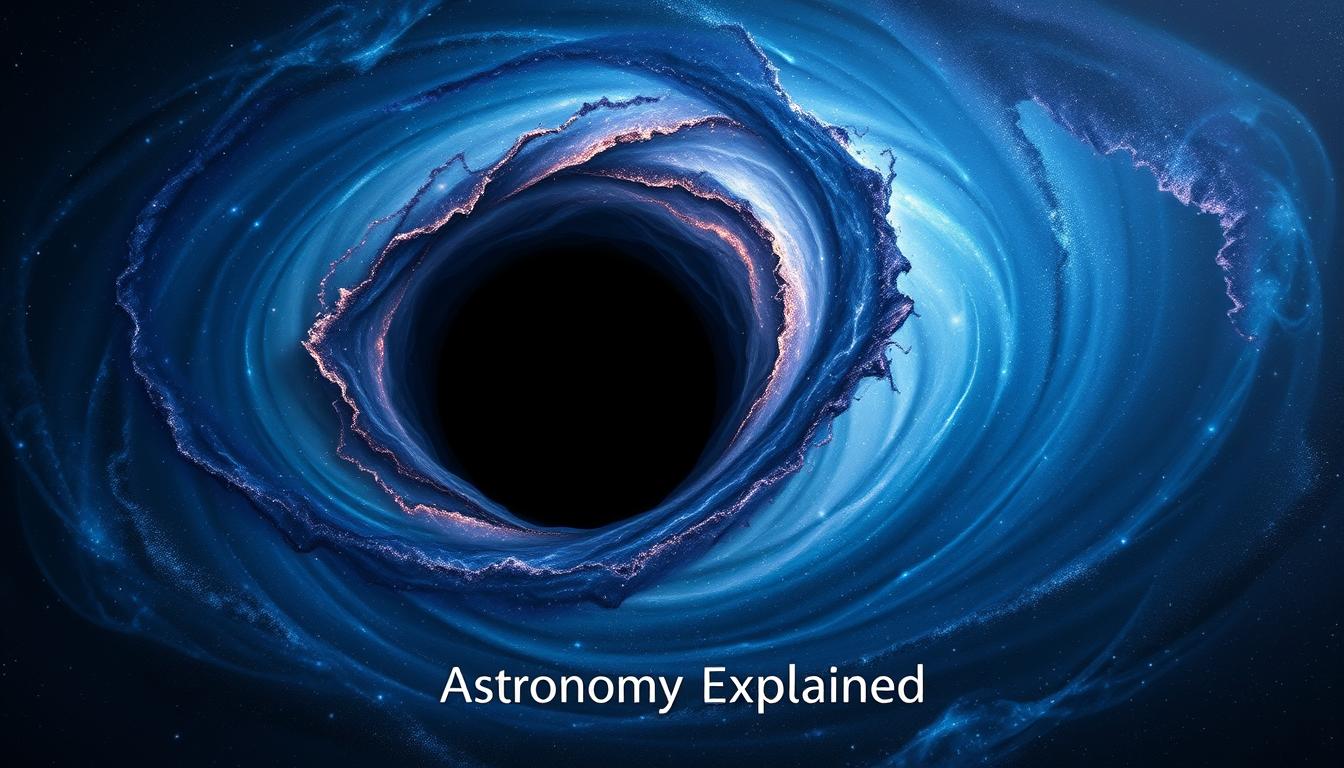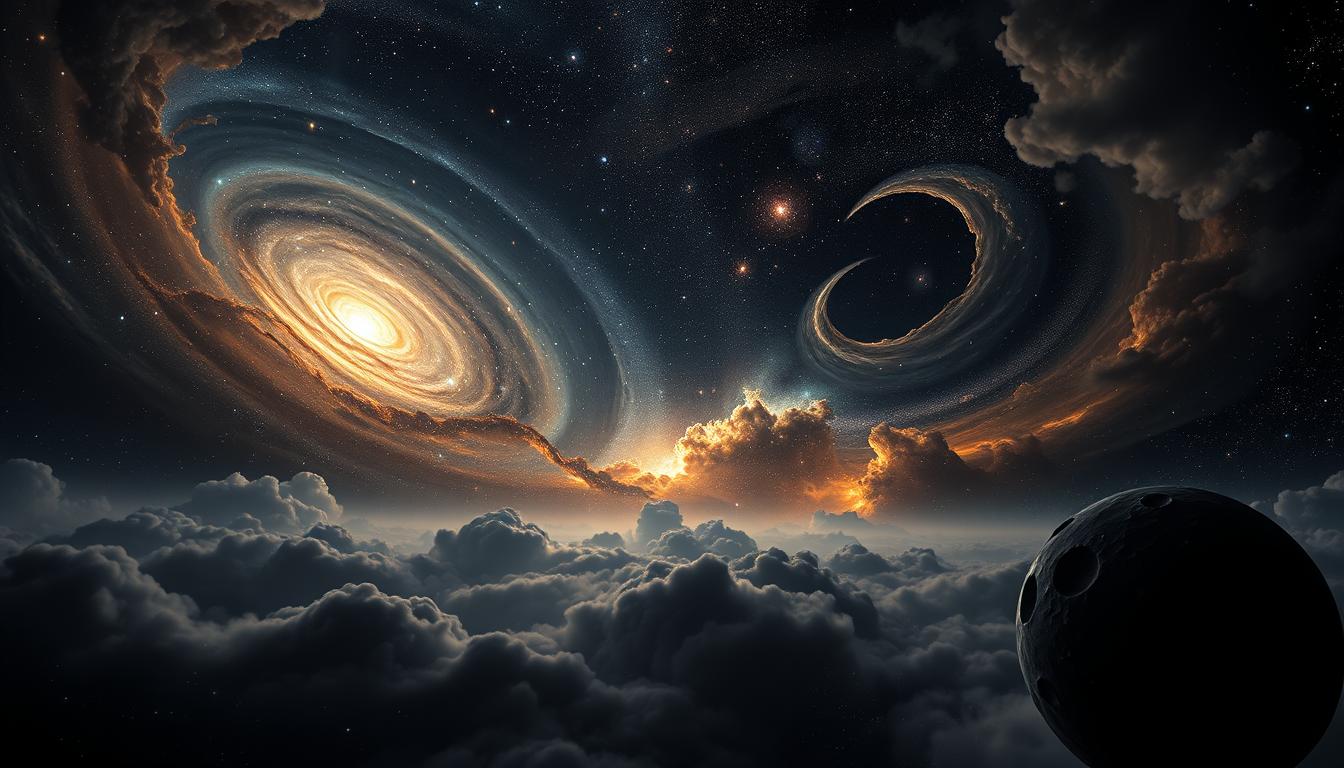Did you know that for every kilogram of stuff we can see, there are 5 kilograms of dark matter? This odd fact points to a big puzzle in space, which we discovered relatively early in the history of the universe’s research. Could dark matter and black holes be connected since they are both very mysterious and their existence may explain some of the stuff? Dark matter is all around us, yet we can’t see it. It pulls on things we can see but stays hidden. Because we can’t see, feel, or measure them, it’s hard to understand dark matter and dark matter’s nature. We don’t even have direct or indirect proof that they exist, but our calculations say that they must. There is a lot of unknown.
Black holes, those cosmic enigmas, might hold a clue about dark matter, and they may point us to the first evidence. Some think tiny black holes from the start of time could be what we call dark matter. These small black holes might explain why we see so much dark stuff out there. They may also create dark matter, or dark matter helped create black holes.
Check this out, too: What is Dark Matter?
There is a lot of research and thoughts going on about the connection between dark matter and black holes – if there is any. In this article, I will try to show you briefly what those are and what the possible connection between dark matter and black holes could be. We’ll look at what dark matter is, how black holes form, and why some think they might be linked.

Nature of Dark Matter: What is Dark Matter?
Dark matter is a mysterious form of invisible matter that makes up a big part of our universe. Scientists think it makes up about 85% of the total mass in the cosmos. This substance doesn’t give off, take in, or reflect light, so we can’t see it. The idea of dark matter came up in the 1960s and 1970s – first by Fristy Zwicky. Astronomers saw that galaxies were spinning faster than expected. They thought an unseen matter was pulling them together, keeping them from flying apart.
Even the thought of dark matter is quite new when you think about it. The first black hole mention was in 1783 by John Michell and Einstein rediscovered the black hole’s existence in 1916. In 1967, we coined the term “black hole”. It wasn’t until 1971 that we detected the first black hole, Cygnus X-1. When you think about it, we are still early in the dark matter’s detection and proving it. Even the term may change.
Properties of Dark Matter
From what we know, dark matter has unique properties. It’s thought to be cold, moving much slower than light. Unlike regular matter, it doesn’t interact with electromagnetic radiation. It’s electrically neutral and doesn’t engage with a strong nuclear force. We mainly detect it through its gravitational pull on visible matter. There is also antimatter which is a completely different thing.
In the standard model of cosmology, dark matter is important. It acts as an invisible framework for galaxies to form and grow. Without it, our universe wouldn’t be as we know it. It’s keeping things together.

Black Holes: Cosmic Enigmas
One of the most science-fiction realities of our universe is the black holes. Even though their initial theoretical discovery goes back to centuries ago, we’ve proved them fairly recently. We even took a picture of a black hole in 2019. Contrary to dark matter, we have good proof of black holes, but black holes and black hole physics still challenge us.
Black holes form when massive stars collapse or in the early universe as primordial black holes. Scientists thought the biggest stellar black holes were 20 solar masses. However, new research shows giants up to 30 solar masses exist. This discovery means more black holes are out there than we thought. It’s a big find for space exploration.
The most interesting thing about black holes is the point of no return. We call this point of return the event horizon. This is where nothing escapes a black hole’s pull. These extreme things about black holes and their physics, how they form and die, and other things make us believe that there may be some proof of dark matter or that some black holes may be dark matter.

Primordial black holes are one of those black holes and examples. They might be dark matter. These ancient cosmic remnants could have formed right after the Big Bang. They could be tiny or supermassive. Recent studies suggest that clusters of primordial black holes could match gravitational wave detector findings. This is a big clue for scientists.
There are many sizes of black holes, and they all can mean something else. They all differ in size, how they come to be, and other details. Stellar-mass black holes come from collapsed stars. Supermassive black holes are at the heart of galaxies. And then there are the elusive primordial black holes, which might be dark matter.
Dark Matter and Black Holes: Exploring the Connection
As I mentioned above, there’s been a lot of ongoing discussion about the connection between dark matter and black holes. This mostly derives from the principles and concept of black holes. They are quite exotic, and we can’t explain anything about them. With us not being able to even prove dark matter and detect it, we started to wonder about the link between dark matter and black holes.
A new theory says primordial black holes might be dark matter. These tiny to huge cosmic objects formed in the universe’s first fraction of a second. Primordial black holes came from a mix of quarks and gluons early on. They could have helped create the first atomic nuclei just after the Big Bang. This idea connects two big mysteries in space: dark matter and how black holes form.

Recent research backs the idea that primordial black holes could be all or most of dark matter. The fact I mentioned in the first sentence, for every kilogram of matter we can see, there are five kilograms we can’t, can explain this link. This matches what we see in the cosmic microwave background and how galaxies act.
The James Webb Space Telescope found supermassive black holes in the early universe. These huge black holes were as massive as a billion suns when the universe was just half a billion years old. This is an insane growth, and we believe that dark matter may helped them.
Primordial Black Holes as Dark Matter Candidates
Scientists have been trying to figure out what dark matter is. It’s about 85% of the universe’s matter. We’ve recently been thinking that maybe one type of black hole, primordial black holes, could be the dark matter that we can detect.
Primordial black holes (PBHs) are much different from most other types of black holes, and that’s why they are unique. Other types of black holes form from the collapse of massive stars, but primordial black holes potentially formed much earlier. We believe they formed right after the Big Bang, during the very early stages of the universe. That’s why they are named primordial. They formed in the primordial era, long before any star or galaxy existed.
Dark matter makes up a huge chunk of the total mass in the universe, but we can’t see it. They don’t give off light or energy – we only know they are there because they pull on things with gravity. This is the same with primordial black holes; they don’t give off light, either. If a lot of primordial black holes were created during the early universe, they might be responsible for some of the “missing” mass we can’t see. This is a relatively good theory because these black holes could group together. When they do, they affect the movement of stars and galaxies similarly to dark matter.
Observational Implications and Future Tests
The James Webb Space Telescope might spot more stars and galaxies around primordial black holes in the early universe. The LISA mission could find more black hole mergers from that time. These findings could prove that primordial black holes are dark matter, changing how we see the universe. Until then, this is still a theory and a big mystery. We have no direct proof that primordial black holes are dark matter.
Conclusion
Even though we are not sure about dark matter or its connection to black holes, I think it’s one of the most realistic concepts about dark matter. It’s also one of the most plausible theories about detecting and potentially seeing dark matter. We know more about black holes than dark matter, but we don’t know if there is a connection between dark matter and black holes. We know that black holes grow 7-20 times bigger over nine billion years. This growth is more than we expected. There are still unanswered questions.
One type of black hole – primordial black holes – could be a definite dark matter candidate. They could be the key to understanding the connection between dark matter and black holes. However, studies of over 1,000 supernovas show they can’t make up more than 23 percent of dark matter. We have a lot more research to do.
FAQ
What is dark matter?
Dark matter is invisible and makes up about 85% of the universe. It doesn’t reflect light, but its pull on visible matter is clear. This is seen in how galaxies move.
What are the properties of dark matter?
Dark matter moves slowly and doesn’t interact with light or strong forces. It pulls on visible objects. It’s thought to be the unseen structure of galaxies.
What is the connection between dark matter and black holes?
Some think primordial black holes could be dark matter. These black holes might have formed right after the Big Bang. They could be tiny or huge.